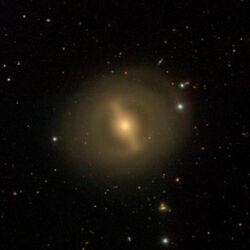Astronomy:NGC 4608
| NGC 4608 | |
|---|---|
 SDSS image of NGC 4608. | |
| Observation data (J2000 epoch) | |
| Constellation | Virgo |
| Right ascension | 12h 41m 13.286s[1] |
| Declination | +10° 09′ 20.38″[1] |
| Redshift | 0.00617[1] |
| Helio radial velocity | 1850 km/s[1] |
| Distance | 56.4 ± 2.6 Mly (17.3 ± 0.8 Mpc)[2] |
| Group or cluster | Virgo Cluster |
| Apparent magnitude (V) | 11.97[1] |
| Characteristics | |
| Type | SB00(r)[1] |
| Size | ~53,105.36 ly (estimated) |
| Apparent size (V) | 3.2′ × 2.7′[1] |
| Other designations | |
| UGC 7842, MCG+02-32-177, PGC 42545[1] | |
NGC 4608 is a barred lenticular galaxy located in the constellation of Virgo. The galaxy was discovered by astronomer William Herschel on March 15, 1784.[3] At about 56 million light-years (17.3 megaparsecs) away,[2] it is a member of the Virgo Cluster.[4]
Physical characteristics
NGC 4608 has a very well-defined bar. Surrounding the bar, there is an inner ring that is defined by a sharp inner edge. Outside of the inner ring,[5] there is a low surface brightness disk[6] that contains weak spiral features.[5]
The center of NGC 4608 is a classical bulge, which is a bulge similar to an elliptical galaxy.[2] The disk in NGC 4608 is practically considered non-existent. One explanation is that the bar in the galaxy was able to form without a disk. Another explanation says that a weak bar forms initially. Over time, the bar grows by causing the external disk to lose angular momentum therefore funneling material toward the bulge. Then the bar would be surrounded by a halo with very little or no disk left.[6]
See also
References
- ↑ 1.0 1.1 1.2 1.3 1.4 1.5 1.6 1.7 "Results for object NGC 4608 (NGC 4608)". NASA/IPAC Extragalactic Database. California Institute of Technology. https://ned.ipac.caltech.edu/byname?objname=NGC%204608&hconst=67.8&omegam=0.308&omegav=0.692&wmap=4&corr_z=1. Retrieved 2021-04-26.
- ↑ 2.0 2.1 2.2 Erwin, Peter; Seth, Anil; Debattista, Victor P.; Seidel, Marja; Mehrgan, Kianusch; Thomas, Jens; Saglia, Roberto; De Lorenzo-Cáceres, Adriana et al. (2021). "Composite bulges – II. Classical bulges and nuclear discs in barred galaxies: The contrasting cases of NGC 4608 and NGC 4643". Monthly Notices of the Royal Astronomical Society 502 (2): 2446–2473. doi:10.1093/mnras/stab126. Bibcode: 2021MNRAS.502.2446E.
- ↑ "New General Catalog Objects: NGC 4600 - 4649" (in en-US). http://cseligman.com/text/atlas/ngc46.htm#4608.
- ↑ "Detailed Object Classifications". https://ned.ipac.caltech.edu/cgi-bin/NEDatt?objname=NGC+4608.
- ↑ 5.0 5.1 "NGC 4608 - SB(r)0/a". http://kudzu.astr.ua.edu/devatlas/NGC_4608______B___________.html.
- ↑ 6.0 6.1 Gadotti, D. A.; de Souza, R. E. (8 January 2003). "NGC 4608 and NGC 5701: Barred Galaxies without Disks?". The Astrophysical Journal 583 (2): L75–L78. doi:10.1086/368159. Bibcode: 2003ApJ...583L..75G.
External links
- NGC 4608 on WikiSky: DSS2, SDSS, GALEX, IRAS, Hydrogen α, X-Ray, Astrophoto, Sky Map, Articles and images
Coordinates: ![]() 12h 41m 13.286s, +10° 09′ 20.38″
12h 41m 13.286s, +10° 09′ 20.38″
 |

